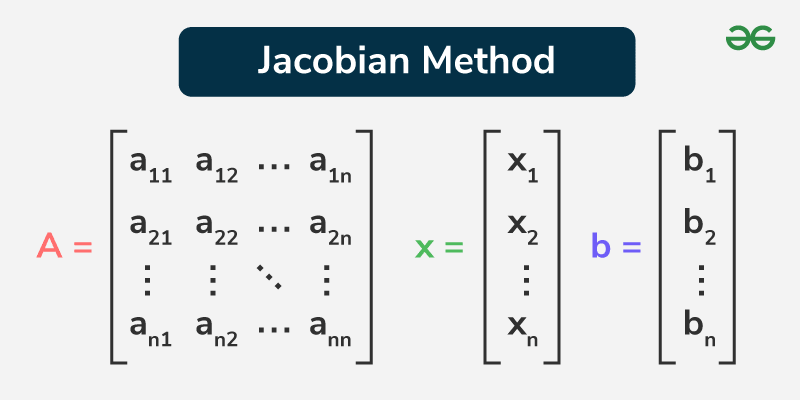
|
|
The Jacobian Method, also known as the Jacobi Iterative Method, is a fundamental algorithm used to solve systems of linear equations. This method, named after the mathematician Carl Gustav Jacob Jacobi, is particularly useful when dealing with large systems where direct methods are computationally expensive. The Jacobian Method works by breaking down a complex set of equations into simpler parts, making it easier to approximate the solutions. The Jacobian method leverages the properties of matrices to find solutions efficiently. Here’s a simple way to understand it: Imagine you have a set of equations, and you need to find the values of certain variables that make all these equations true simultaneously. Instead of solving everything at once, the Jacobian Method starts with an initial guess for these values. It then repeatedly refines this guess, step by step, getting closer to the actual solution with each iteration. This article will discuss the principles, applications, and advantages of the Jacobian method, highlighting its significance in computational mathematics and engineering disciplines. Table of Content What is the Jacobian Method?Jacobian Method, often referred to as the Jacobi Method, is an iterative algorithm used for solving systems of linear equations. It is particularly useful for large systems where direct methods (like Gaussian elimination) are computationally expensive. The method is named after Carl Gustav Jacob Jacobi, a German mathematician.  Jacobian Method Basics of Jacobian MethodThe method is used to solve a system of linear equations of the form:
Where A is a square matrix, x is the vector of unknowns, and b is the right-hand side vector. The Jacobi Method decomposes the matrix A into its diagonal component D and the remainder R, such that:
The system of equations can then be rewritten as:
The iterative formula for the Jacobi Method is:
Where xk is the approximation of the solution at the kth iteration. Jacobi Iterative Implementation of Jacobian MethodThe Jacobi iterative method is a specific implementation of the Jacobian method. It assumes that the system of linear equations can be written in the form Ax = b, where A is the coefficient matrix, x is the vector of unknown variables, and b is the vector of constants. The Jacobi method proceeds as follows:
Steps for Jacobi Iterative MethodWe can use the following steps:
Let’s consider an example for better understanding: Example : Consider the system of linear equations:
Jacobian Method in Matrix FormLet the system of linear equations be Ax = b, where A is the coefficient matrix , x is the vector of unknown variables, and b is the vector of constants. [Tex]\begin{array}{cccccc} a_{11} x_1^{(k+1)} & + & a_{12} x_2^{(k)} & + \cdots + & a_{1n} x_n^{(k)} & = b_1 \\ a_{21} x_1^{(k)} & + & a_{22} x_2^{(k+1)} & + \cdots + & a_{2n} x_n^{(k)} & = b_2 \\ \vdots & & \vdots & & \vdots & \vdots \\ a_{n1} x_1^{(k)} & + & a_{n2} x_2^{(k)} & + \cdots + & a_{nn} x_n^{(k+1)} & = b_n \end{array}[/Tex] We can decompose the matrix A into three parts:
[Tex]\begin{bmatrix} a_{11} & 0 & \cdots & 0 \\ 0 & a_{22} & \cdots & 0 \\ \vdots & \vdots & \ddots & \vdots \\ 0 & 0 & \cdots & a_{nn} \end{bmatrix} \begin{bmatrix} x_1^{(k+1)} \\ x_2^{(k+1)} \\ \vdots \\ x_n^{(k+1)} \end{bmatrix} + \begin{bmatrix} 0 & a_{12} & \cdots & a_{1n} \\ a_{21} & 0 & \cdots & \vdots \\ \vdots & \vdots & \ddots & \vdots \\ a_{n1} & \cdots & a_{n,n-1} & 0 \end{bmatrix} \begin{bmatrix} x_1^{(k)} \\ x_2^{(k)} \\ \vdots \\ x_n^{(k)} \end{bmatrix} = \begin{bmatrix} b_1 \\ b_2 \\ \vdots \\ b_n \end{bmatrix}[/Tex] The Jacobi iteration can then be written as:
The element-based formula for the Jacobi method can be written as:
This formula shows how the (k+1)th approximation of the ith variable is computed using the kth approximations of the other variables. Difference between Jacobian method and Gauss-Seidel Method
Solved Examples on Jacobian Method1: Consider the system of linear equations:2x+y+z=6x+3y-z=0-x+y+2z=3
2: Consider the following system of linear equations:3x+2y-z=72x-y+4z=13x+3y+2z=12
ConclusionJacobian Method is a powerful tool for solving systems of linear equations, especially when those systems are large and complex. By breaking down a big problem into smaller, more manageable parts, the Jacobian Method makes it easier to find solutions step-by-step. It works well when you have a good initial guess and when the system of equations meets certain conditions. Jacobian Method – FAQsWhy do we use the Jacobian method?
What is the Jacobi method limitation?
What are the assumptions of the Jacobi method?
What is another name for Jacobi’s method?
Who founded the Jacobi method?
|
Reffered: https://www.geeksforgeeks.org
| Engineering Mathematics |
Type: | Geek |
Category: | Coding |
Sub Category: | Tutorial |
Uploaded by: | Admin |
Views: | 23 |